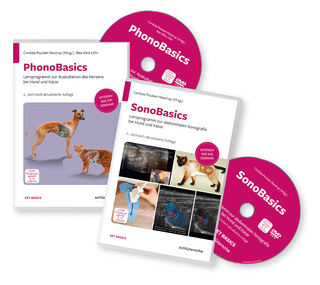
Small Animal ECGs – An Introductory Guide 2e
Wiley-Blackwell (Hersteller)
978-0-470-69208-0 (ISBN)
- Keine Verlagsinformationen verfügbar
- Artikel merken
This book provides all the information that veterinarians need when using electrocardiography techniques for the first time. It is aimed squarely at the beginner, and is designed specifically for ease of use. It includes not only ECG tracings, but also clear and simple explanatory diagrams that accompany the text. * Written by a Recognised Specialist in Veterinary Cardiology * New chapters on the management and treatment of arrhythmias and on choosing an ECG recorder * Suitable for all veterinary professionals, including practitioners, veterinary students, nurses and technicians
Mike Martin holds the Diploma in Veterinary Cardiology and is RCVS Specialist in Veterinary Cardiology. He runs his own specialist referral practice, the Veterinary Cardiorespiratory Centre, in Kenilworth, Warwickshire.
Preface To Second Edition. Preface To First Edition. About The Author. Acknowledgements. Part I: Understanding The Electricity Of The Heart And How It Produces An ECG Complex. 1. What Is An ECG?. 2. The Electricity Of The Heart. Formation Of The Normal P-QRS-T Complex. Nomenclature Of The QRS Complex. 3. Rhythms Of Sinus Origin. Sinus Rhythm. Sinus Arrhythmia. Sinus Tachycardia. Sinus Bradycardia. Part II: Abnormal Electricity Of The Heart. 4. Recognising And Understanding Ectopia. First Identify The Morphology Of The Normal QRS Complex. The Morphology Of An Ectopic Ventricular Depolarisation. The Morphology Of An Ectopic Supraventricular Depolarisation. 5. Arrhythmias Associated With Ectopia. Ventricular Premature Complexes. Supraventricular Premature Complexes. Escape Rhythms. AV Dissociation. Fibrillation. 6. Abnormalities In The Conduction System. Sinus Arrest And Block. Sick Sinus Syndrome. Atrial Standstill. Heart Block. 7. Changes In The P-QRS-T Morphology. Wandering Pacemaker. Changes Associated With Chamber Enlargement. Left Atrial Enlargement. Right Atrial Enlargement. Left Ventricular Enlargement. Right Ventricular Enlargement. Abnormal Mean Electrical Axis (MEA). Low-Voltage QRS Complexes. Electrical Alternans. Notching In The R Wave. Q-T Interval Abnormalities. S-T Segment Abnormalities. Abnormalities Of The T Wave. Hyperkalaemia. Part III: More Advanced Electrocardiography. 8. Understanding The ECG Limb Lead Systems. The Six ECG Limb Leads. 9. Mean Electrical Axis Explained. How To Calculate The Mean Electrical Axis. 10. Intraventricular Conduction Defects. Right Bundle Branch Block. Left Bundle Branch Block. Left Anterior Fascicular Block. Intermittent Ventricular Aberrancy. 11. Some Additional Arrhythmias. Ventricular Pre-Excitation. Atrial Flutter. Accelerated Idioventricular Rhythm. Part IV: Management And Treatment Of Arrhythmias. 12. Management Of Arrhythmias. Does The Arrhythmia Suggest The Presence Of An Underlying Condition?. Is The Arrhythmia Of Primary Clinical Significance?. 13. Treatment Of Arrhythmias. Bradyarrhythmias. Tachyarrhythmias. 14. Pacemakers. Indications. Contraindications. Disadvantages. Complications. Prior Diagnostics. Equipment. Types Of Permanent Pacemakers. Techniques Of Implantation. Pacemaker Follow-Up. Hazards. Part V: Recording And Interpreting ECGs. 15. Approach To The Interpretation Of The ECG Recording. To Calculate The Heart Rate (Given As Beats Per Minute). Determine The Rhythm. Measure The Complex Amplitudes And Intervals. 16. Artifacts. Electrical Interference. Muscle Tremor Artifact. Movement Artifact. Incorrectly Placed Electrodes. 17. Recording An ECG. The Connectors (Electrodes). Making The Connection. Where To Place The Electrodes. Isolating The Electrodes. How To Position The ECG Cables. Positioning The Animal. Setting Up And Preparing The ECG Machine. Recording An ECG - A Suggested Routine. 18. Choosing An ECG Recorder. Quality. Continuous Recording. Ease Of Use. Automatic Labelling. Automatic Vs. Manual Recording Mode. Interpretative Software. Multichannel Vs. Single Channel. Precordial Chest Leads. Calibration Settings. Automatic Centring Vs. Manual Control. Internal Battery. Jack Plug Lead Fitting. Monitor Screen. Thermal Paper Vs. Ink Paper. New Vs. Second Hand. Summary Of Features To Look For In An ECG Recorder. Further Reading. Index
| Erscheint lt. Verlag | 15.4.2008 |
|---|---|
| Verlagsort | Hoboken |
| Sprache | englisch |
| Maße | 158 x 234 mm |
| Gewicht | 272 g |
| Themenwelt | Veterinärmedizin ► Kleintier |
| ISBN-10 | 0-470-69208-1 / 0470692081 |
| ISBN-13 | 978-0-470-69208-0 / 9780470692080 |
| Zustand | Neuware |
| Haben Sie eine Frage zum Produkt? |
aus dem Bereich
